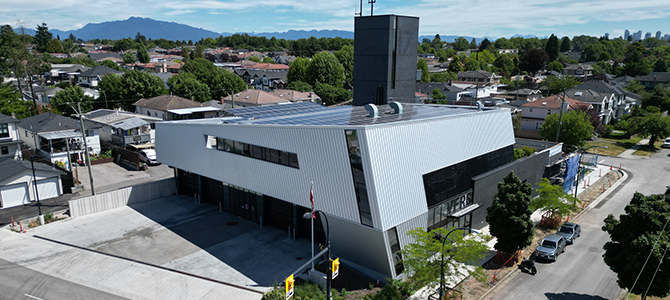
Vancouver’s zero-carbon firehall now open
September 11, 2023 | By HPAC Magazine
Firehall 17, with geothermal heat pumps for heating/cooling, is also on track to achieve Passive House certification.

(source: City of Vancouver)
Canada’s first ever zero-carbon firehall is now open, providing essential fire and rescue services, while showcasing a green design approach.
Vancouver first announced the project back in 2018, and now the city’s Firehall 17 is an example of municipal leadership on climate action and is paving the way for future buildings to achieve near zero emissions.
According to the city, nearly 60% of the municipality’s carbon pollution comes from burning gas to heat buildings and hot water. The new firehall was constructed to a zero emissions standard and achieved LEED Gold certification and Net Zero Energy as defined by the Federation of Canadian Municipalities. It is also on track to achieve Passive House certification.
“It is a demonstration we can make near zero-emissions buildings the new normal, while also helping to reduce energy and water consumption costs,” said Ken Sim, Mayor of Vancouver, in a media release.
Located at 7070 Knight Street, the new firehall is the second largest training site for Vancouver Fire Rescue Services. The expanded building is also designed to be a post-disaster communications hub and fitted with equipment needed to keep the community connected in the event of a disaster, such as an earthquake.
The original fire hall was constructed in 1954, and the facility underwent a significant renewal with construction completed in the spring of 2022. Introba (formerly Integral Group) led the mechanical engineering and design, which includes a geo-exchange field coupled with ground source heat pumps for the heating and cooling water throughout the building. The overall gross floor area is approximately 22,000 sq. ft.
The facility reduces operational carbon emissions by 99.67% from the previous building at that location.
The building was divided into two separately certifiable Passive House zones: Zone A for living areas, running at 20C, and Zone B for four drive-through apparatus bays and a full-size hose/training tower, running at 10C in winter and 25C in summer.
According to Introba, the “high-performance building envelope allows the geo-exchange field to be a fifth of the size compared to an equivalent building built to minimum code standards.”
Design strategies also include efficient air, heat and water recovery systems including high-performance heat recovery ventilation (HRV), and an on-site solar PV array that can allow the all-electric post-disaster fire hall to remain operationally resilient in the wake of disaster.
“This state-of-the-art facility will ensure City of Vancouver is resilient to potential disasters,” said Karen Fry, Fire chief and general manager of Vancouver Fire Rescue Services. “The new Firehall 17 is part of Vancouver Fire Rescue Services long-term fire hall plan and will meet service needs for the next few decades.”
https://vancouver.ca/your-government/fire-hall-17.aspx




